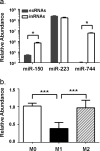Macrophage polarization and meta-inflammation
- PMID: 29154757
- PMCID: PMC5776711
- DOI: 10.1016/j.trsl.2017.10.004
Macrophage polarization and meta-inflammation
Abstract
Chronic overnutrition and obesity induces low-grade inflammation throughout the body. Termed "meta-inflammation," this chronic state of inflammation is mediated by macrophages located within the colon, liver, muscle, and adipose tissue. A sentinel orchestrator of immune activity and homeostasis, macrophages adopt variable states of activation as a function of time and environmental cues. Meta-inflammation phenotypically skews these polarization states and has been linked to numerous metabolic disorders. The past decade has revealed several key regulators of macrophage polarization, including the signal transducer and activator of transcription family, the peroxisome proliferator-activated receptor gamma, the CCAAT-enhancer-binding proteins (C/EBP) family, and the interferon regulatory factors. Recent studies have also suggested that microRNAs and long noncoding RNA influence macrophage polarization. The pathogenic alteration of macrophage polarization in meta-inflammation is regulated by both extracellular and intracellular cues, resulting in distinct secretome profiles. Meta-inflammation-altered macrophage polarization has been linked to insulin insensitivity, atherosclerosis, inflammatory bowel disease, cancer, and autoimmunity. Thus, further mechanistic exploration into the skewing of macrophage polarization promises to have profound impacts on improving global health.
Published by Elsevier Inc.
Conflict of interest statement
All authors have read the journal’s policy on disclosure of potential conflicts of interest and the authors declare that they have no conflicts of interest with the contents of this article.
Figures


Similar articles
-
The Prostaglandin E2 Receptor EP4 Regulates Obesity-Related Inflammation and Insulin Sensitivity.PLoS One. 2015 Aug 26;10(8):e0136304. doi: 10.1371/journal.pone.0136304. eCollection 2015. PLoS One. 2015. PMID: 26308623 Free PMC article.
-
Impaired macrophage autophagy increases the immune response in obese mice by promoting proinflammatory macrophage polarization.Autophagy. 2015;11(2):271-84. doi: 10.1080/15548627.2015.1009787. Autophagy. 2015. PMID: 25650776 Free PMC article.
-
MiR-130b promotes obesity associated adipose tissue inflammation and insulin resistance in diabetes mice through alleviating M2 macrophage polarization via repression of PPAR-γ.Immunol Lett. 2016 Dec;180:1-8. doi: 10.1016/j.imlet.2016.10.004. Epub 2016 Oct 13. Immunol Lett. 2016. PMID: 27746169
-
Macrophage polarization and function with emphasis on the evolving roles of coordinated regulation of cellular signaling pathways.Cell Signal. 2014 Feb;26(2):192-7. doi: 10.1016/j.cellsig.2013.11.004. Epub 2013 Nov 9. Cell Signal. 2014. PMID: 24219909 Review.
-
Adipocyte-Macrophage Cross-Talk in Obesity.Adv Exp Med Biol. 2017;960:327-343. doi: 10.1007/978-3-319-48382-5_14. Adv Exp Med Biol. 2017. PMID: 28585206 Review.
Cited by
-
The AGEs/RAGE Signaling Pathway Regulates NLRP3-Mediated Neuronal Pyroptosis After MCAO Injury in Lepr-/- Obese Rats.J Inflamm Res. 2024 Oct 1;17:6935-6954. doi: 10.2147/JIR.S476458. eCollection 2024. J Inflamm Res. 2024. PMID: 39372588 Free PMC article.
-
Macrophages at the Crossroad of Meta-Inflammation and Inflammaging.Genes (Basel). 2022 Nov 9;13(11):2074. doi: 10.3390/genes13112074. Genes (Basel). 2022. PMID: 36360310 Free PMC article. Review.
-
Sirtuins: Key players in obesity-associated adipose tissue remodeling.Front Immunol. 2022 Nov 24;13:1068986. doi: 10.3389/fimmu.2022.1068986. eCollection 2022. Front Immunol. 2022. PMID: 36505468 Free PMC article. Review.
-
Dimethyl itaconate ameliorates cognitive impairment induced by a high-fat diet via the gut-brain axis in mice.Microbiome. 2023 Feb 21;11(1):30. doi: 10.1186/s40168-023-01471-8. Microbiome. 2023. PMID: 36810115 Free PMC article.
-
Chronic stress: a critical risk factor for atherosclerosis.J Int Med Res. 2019 Apr;47(4):1429-1440. doi: 10.1177/0300060519826820. Epub 2019 Feb 24. J Int Med Res. 2019. PMID: 30799666 Free PMC article. Review.
References
-
- Smith KB, Smith MS. Obesity Statistics. Prim Care. 2016;43(1):121–35. ix. - PubMed
-
- Reaven GM. Banting lecture 1988. Role of insulin resistance in human disease. Diabetes. 1988;37(12):1595–607. - PubMed
-
- Kaplan NM. The deadly quartet. Upper-body obesity, glucose intolerance, hypertriglyceridemia, and hypertension. Arch Intern Med. 1989;149(7):1514–20. - PubMed
-
- Haffner SM, Valdez RA, Hazuda HP, Mitchell BD, Morales PA, Stern MP. Prospective analysis of the insulin-resistance syndrome (syndrome X) Diabetes. 1992;41(6):715–22. - PubMed
-
- Hotamisligil GS. Inflammation and metabolic disorders. Nature. 2006;444(7121):860–7. - PubMed
Publication types
MeSH terms
Substances
Grants and funding
LinkOut - more resources
Full Text Sources
Other Literature Sources
Medical
Miscellaneous

